
December 2017
Aftermath of Irma and María … and the Devastating Debt Crisis
Colonial Capitalist Disaster
in Puerto Rico
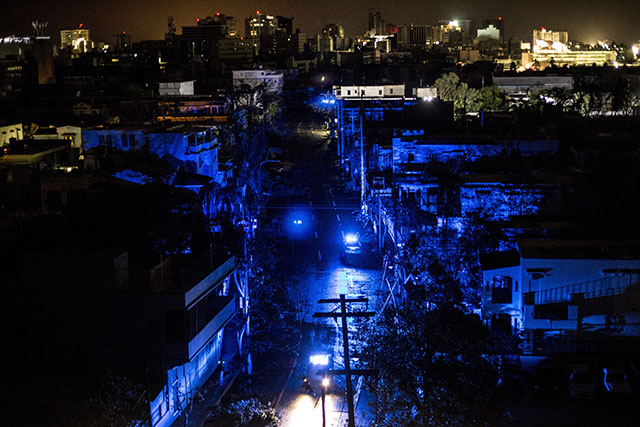
San Juan, the capital of Puerto Rico, plunged into darkness on the night of September 20. Two and a half months later, most residents of the island colony still do not have electrical power. (Photo: Alex Wroblewski/Getty Images)
The effects of “natural” disasters are always refracted through the prism of the man-made class societies in which they occur. The horror show that followed the double-whammy of back-to-back Category 5 hurricanes that swept through the Antilles island chain in September is no exception. In Puerto Rico, the immediate toll of death and destruction has been magnified many times over by U.S. imperialist rule, which ever since it conquered in 1898 has treated the population as colonial subjects and second-class citizens. Now with the wholesale destruction of the island’s industry since 1996, intensified by the decade-old world capitalist economic crisis, imperialist domination increasingly threatens the very existence of the Puerto Rican nation.
On September 20, Hurricane Maria made landfall in Puerto Rico. The Caribbean island was still struggling to recover from the damage done by Hurricane Irma, which had hit two weeks earlier. María exacerbated the damage by orders of magnitude. Debris created by Irma became deadly projectiles as Maria wreaked havoc. 80% of the crops were destroyed. Floodwaters reached a depth of 15 feet in some areas. Power lines and the concrete poles holding them were blown to the ground. Dozens of hundred-foot-tall transmission towers for high-voltage trunk lines collapsed, cutting off the whole northern side of the country from electricity. Two and a half months later, over half of Puerto Rico’s population still is without electrical power.
The U.S. government has consistently tried to minimize the vast extent of the damage. President Donald Trump dismissively compared María to Hurricane Katrina in New Orleans, which he called a “real catastrophe,” repeating Puerto Rican governor Ricardo Rosselló’s statement that “only” 16 people had died in Puerto Rico. The colonial government kept repeating for weeks that only 55 people perished in the aftermath of María. But CNN reported in late November that just by calling half the funeral homes on the island it came up with at least 499 deaths because of the hurricanes, suggesting a much higher toll, while social scientists comparing the numbers of reported deaths to past years calculated the actual count at well over 1,000 people (Vox, 29 November).
Many Puerto Ricans, and millions of others, were outraged at the sight of Trump, the would-be capitalist savior of Puerto Rico, throwing paper towels into a crowd of people, as if he were tossing out T-shirts at a sports event. This image summed up his flippant attitude towards the crisis the hard-hit island faces. Proclaiming the utterly inadequate Federal Emergency Management Agency (FEMA) efforts “amazing,” “tremendous,” “incredible” and “really good,” he gave his administration a “10” out of 10 for its belated relief actions. Trump even dedicated a golf tournament trophy to the people suffering the effects of the storm. But golf trophies and paper towels have done nothing to ease the torment the Puerto Rican people have been enduring … which didn’t begin with Hurricanes Irma and María.
Colonial Subjugation and the
Depopulation of Puerto Rico
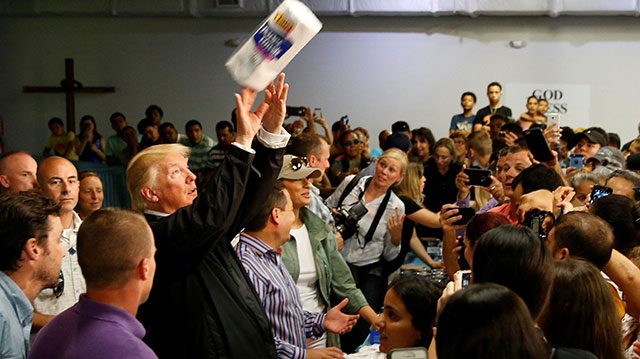
Donald Trump during his four-hour visit to hurricane-battered Puerto Rico tosses paper towels into a crowd at a chapel in San Juan. They were “beautiful, soft towels . . . very good towels,” the U.S. president said later in an interview. “I was having fun.” The people of Puerto Rico, not so much. (Photo: Jonathan Ernst/Reuters)
Even many liberals, generally oblivious to the workings of U.S. imperialism, were shocked by the egregious mistreatment of Puerto Rico following the storms. More than once we heard (including from clueless union bureaucrats) the comment that the island was being “treated like, like a colony,” which is exactly what it is – the United States’ oldest territorial “possession” and the largest remaining colony in the world. Although Puerto Ricans are American citizens and subject to federal laws, island residents have no representation in Congress and cannot vote for president – not that elections controlled by Wall Street and other billionaires give working people on the mainland any say in “their” government. But since last year, an unelected capitalist junta tightly controls the island’s finances under the “Puerto Rico Oversight, Management and Economic Stability Act” (PROMESA, or “promise” in Spanish).
There is a lot of finger-pointing going on in the post-María blame game. Donald Trump made sure to remind Puerto Ricans about the “broken infrastructure and massive debt” the island faces, complaining that “we’ve spent a lot of money on Puerto Rico.” When acting Homeland Security secretary Elaine Duke incredibly claimed that the response to the hurricane was a “good news story,” San Juan mayor Carmen Yulín Cruz responded, “This is a ‘people are dying’ story.” Trump’s answer was to blame the slow response to the crisis on “poor leadership ability by the mayor of San Juan, and others in Puerto Rico, who are not able to get their workers to help.” Trump and other U.S. capitalists create the racist stereotype of supposedly lazy Puerto Ricans – as they are desperately struggling for survival! – in order to blame their situation on the victims, and thus to perpetuate the cycle of debt and poverty.
Mayor Cruz described Trump’s four-hour photo-op visit to the island as “insulting to the people of Puerto Rico.” Yet she also said that Trump’s staff “seemed to want to approach this a different way” than their boss. What willful blindness! Donald Trump is hardly the only proponent of racist, imperialist policies toward Puerto Rico. Cruz is affiliated with the Popular Democratic Party (PDP), linked to the Democratic Party in the U.S. It was Democratic president Bill Clinton who set off the deindustrialization of Puerto Rico in 1996, and Democratic president Barack Obama who last year appointed the grotesquely misnamed PROMESA junta to pay off his Wall Street backers while imposing vicious austerity on Puerto Rican workers. As a member of a colonial ruling class, Cruz is part of the structure of imperialist domination of Puerto Rico.
During Trump’s brief visit to Puerto Rico, Mayor Cruz said to him, “Mr. Trump, it’s about saving lives. It’s not about politics.” Asked about Cruz’s pleas for disaster relief, FEMA director Brock Long responded: “We filtered out the mayor a long time ago. We don’t have time for the political noise.” To categorize requests for water and other essential resources as “political noise” is to treat the suffering of a subjugated people as a mere nuisance. Their lives are of little concern to the imperialist rulers. And, of course, this crisis is all about politics. It is about a U.S. colony that has faced over a century of economic, social and political oppression. The political debility of even bourgeois Puerto Rican politicians reflects this status, and that subjugation will not cease because of absurd calls on the imperialists to be “caring” overlords.
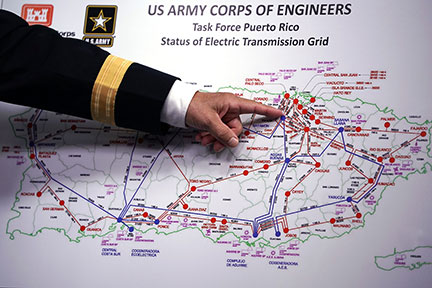 U.S. Army Corps of Engineers has
virtually blocked restoration of power lines in eastern Puerto
Rico. Shown here: Pentagon briefing, October 20.
U.S. Army Corps of Engineers has
virtually blocked restoration of power lines in eastern Puerto
Rico. Shown here: Pentagon briefing, October 20. (Photo: Chip Somodevilla/Getty Images)
Under Republicans or Democrats, U.S. policy toward Puerto Rico is anything but altruistic. What has Washington actually done during the present crisis? It eventually sent the hospital ship USS Comfort, which mostly sat empty in the San Juan harbor. It dispatched 10,000+ troops to “keep order,” distribute some meals-ready-to-eat and bottled water for a few days and install some mobile cell phone towers. The U.S. Army Corps of Engineers was even slower than the notorious fly-by-night Whitefish, Montana company in beginning repairs of power lines in the eastern third of the island. In recent days, it awarded a $841 million contract to Fluor Enterprises, which made billions off of reconstruction contracts in New Orleans and Iraq.
Meanwhile, poor and working people in Puerto Rico are fighting for survival. Many still lack clean water, cell service and electricity. Many homes have been either destroyed or flooded. The result of the hurricanes and their aftermath has been a massive exodus from the island. In early October, a report by the Center for Puerto Rican Studies at Hunter College in the City University of New York projected that “between 114,000 and 213,000 Puerto Rico residents will leave the island annually in the aftermath of Hurricane Maria,” with as many as 82,000 moving to Florida.1 The actual figures are much higher. By late November, some 208,000 Puerto Ricans had left the island for Florida alone, and flights to Miami and Orlando are fully booked through the end of the year. But this only intensifies a trend that has been going on for the last decade.
The most dramatic population change shown by the CPRS report is that from the start of the island’s economic crisis in 2006, when the number of Puerto Ricans living on the island and in the mainland U.S. were roughly equal, the island population has dwindled to about 3.4 million people while the number of “stateside” Puerto Ricans has risen to 5.5 million. On this island where before Irma and María the average income per person was half that in the poorest U.S. state (Mississippi) and 43.5% of the population had incomes below the federal poverty level, things just got much worse. The number of industrial jobs in Puerto Rico has been cut in half since 1996, and many plants are still not up and running following María, or are barely limping along for lack of power and supplies.
The depopulation of Puerto Rico reflects the deep cuts in its living standards. The massive destruction could have been largely prevented, if it had the resources to properly maintain its infrastructure and prepare for natural disasters. For decades, the island colony was treated by the U.S. as a backwater with rampant poverty. There was a period of economic growth in the 1960s and ’70s as the U.S. pumped resources into the island to make it a showcase and military bastion in response to the Cuban Revolution. Tax breaks (Section 936) attracted pharmaceutical giants. But the end of the anti-Soviet Cold War at the onset of the 1990s led to the canceling of these programs. As its tax base dwindled, Puerto Rico’s colonial government resorted to growing debt as poverty escalated. The hurricane exacerbated existing deteriorating conditions on the island.
Privatizers, Profiteers and Union-Busters Take Aim at PR Electrical Workers
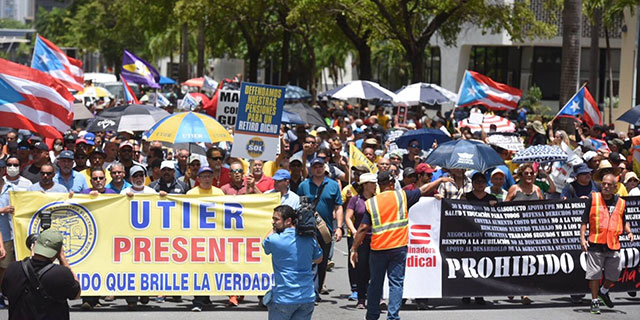
Electrical workers union UTIER, the Coordinadora Sindical and other Puerto Rican labor federations march on the offices of the Financial Control Board (known as “la Junta”) in San Juan's Goldon Mile, August 30, protesting against cuts to wages and pensions in order to pay off Wall Street vulture financiers. (Photo: Metro PR)
Puerto Rico is undergoing perhaps the longest nationwide blackout in history. The entire electrical system on the island effectively collapsed. While the number of those affected is vastly smaller than giant power outages in India, Turkey, Brazil and elsewhere, those were relatively brief. In this case, well over a million people may be without electricity for four months or more. The Puerto Rican Electrical Power Authority says that as of November 27, 58% of its power generating capacity has been restored. But the power plants were not crippled, it was the distribution system, and some priority users like hospitals use far more electricity than a single family. In fact, most Puerto Ricans homes are still without power, and on St. Croix, the largest of the U.S. Virgin Islands, almost three-quarters of the population has no electricity.
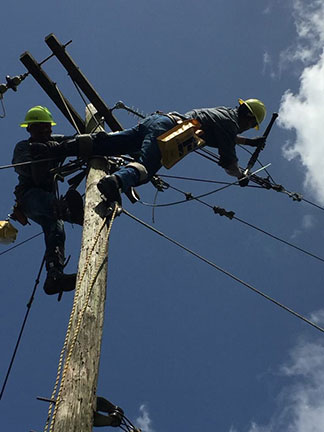 Union electrical workers repairing downed
power lines after Hurricanes Irma and Maria. (Photo: UTIER)
Union electrical workers repairing downed
power lines after Hurricanes Irma and Maria. (Photo: UTIER)Moreover, prior to the hurricanes, Puerto Rico had severely polluted drinking water due to its dilapidated infrastructure and financial inability to improve conditions. Flooding from the hurricanes has caused further contamination of fresh water by sewage. Two and a half months after María, one-fifth of the population still does not have access to potable running water. While so far a major outbreak of water-borne disease has been avoided, contaminants abound in Puerto Rico. The outlying island of Vieques was used as a site for bomb testing by the U.S. government. Next to a power plant in Guayama in southern Puerto Rico there is a mountain of coal ash, containing arsenic, mercury and chromium. Most landfills are full to overflowing, and desperate people have been drinking water from wells on Superfund toxic waste dumps.
As for a long-term solution to Puerto Rico’s energy crisis, a group of electrical engineers at the University of Puerto Rico’s Mayagüez campus argues that switching to greater use of solar power makes sense on an island with lots of sun, limited hydroelectric potential and no oil. South African capitalist wunderkind Elon Musk sent hundreds of Tesla solar panel battery packs to the disaster-stricken island, hoping to eventually rake in big bucks in profits. But while Puerto Rican governor “Ricky” Rosselló says he is enticed by Musk’s offer, there is a crisis that needs to be dealt with now, and that doesn’t stem from nobody ever having thought of a better way to provide power for the island. The energy crisis is the direct result of years of criminal negligence of upkeep, managerial corruption, financial looting by creditors and flat-out union-busting.
Puerto Rico’s Autoridad de Energía Eléctrica (AEE, or PREPA, for Puerto Rican Power Authority, in English) is the focus of a privatization offensive fostered by Rosselló of the New Progressive Party (PNP, linked to the U.S. Republicans) and the rest of the colonial capitalist rulers. The aim is to drive this largest publicly owned utility on U.S. territory into the ground, and then sell it off. The AEE is $9 billion in debt. With no money to properly sustain the power grid, even before the hurricane hit, the authority said it needed $4 billion to for urgently needed repairs and upgrades. There were not even enough funds to prune trees growing too close to power lines, which could have helped prevent this widespread loss of power. In July, the AEE filed for bankruptcy, saying it was unable to maintain its “degraded and unsafe” infrastructure.
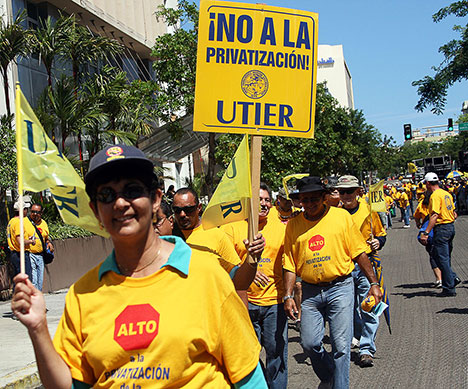 UTIER struck and marched in May
2012 against plans to privatize Puerto Rican Power Authority.
UTIER struck and marched in May
2012 against plans to privatize Puerto Rican Power Authority.
(Photo: Indymedia PR)
A main purpose of the privatization offensive is to break the historically militant electrical workers union UTIER (the Unión de Trabajadores de la Industria Eléctrica y Riego). For decades, Puerto Rico’s capitalist rulers have been going after UTIER, as well as other unions on the island. When, in 1998, then-governor Pedro Rosselló (father of “Ricky”) launched a drive to privatize the profitable Puerto Rico Telephone Company, this culminated in a general strike of which the UTIER was the backbone. Hundreds of thousands of workers shut down most of the island’s economy and government for two days but were eventually defeated by vicious police repression and the capitulation of the union leaders (see “Puerto Rico General Strike – Forge a Revolutionary Workers Party!” and “Balance Sheet of the General Strike: Puerto Rican Workers Mobilize, Union Tops Cave In,” in The Internationalist No. 6, November-December 1998).
Ever since the 1980s, Puerto Rican colonial governments under both the PNP and PDP have been pushing the privatization drive, preparing the way by starving government-owned services of funds. As a result, the AEE cut its workforce by 30% and the number of linesmen was slashed by more than half. Even before the recent hurricanes destroyed the power grid, the shortage of trained electrical workers and deferred maintenance resulted in frequent power outages. In September 2016, the entire island was left without electricity for three days after an explosion damaged the key Central Aguirre plant on the south coast. This past August the giant Palo Seco plant, which supplies San Juan on the north coast, was shut down as unsafe. After Hurricane Irma, all the Power Authority’s emergency supplies were used up.
Using the debt and energy crises as levers, Wall Street financiers are looking forward to a fire sale of Puerto Rico’s public utility. Like pigs at a feeding trough, they are drawn to the smell of profit above all else. The PROMESA Oversight Board has appointed a retired Air Force colonel as “chief transformation officer” to prepare the privatization of the AEE, and they are eagerly assisted by the endlessly corrupt satraps in the colonial government. AEE chief executive Ricardo Ramos awarded the now-notorious no-bid, no-oversight contract to Whitefish Energy for the clear purpose of buying influence with the Trump regime, whose Interior Secretary is from the same small town in Montana and pals with the company’s owner. The fact that the contract was canceled and Ramos was forced to resign is little consolation for the millions suffering in the dark on “generator island.”
None of the bourgeois forces give a damn about the suffering of the poor and working people of Puerto Rico, or even the hard-hit middle class now facing ruin in the island’s economic and physical collapse. The only real solution is to bring out the power of the working class in a fight leading to socialist revolution on the island and the U.S. mainland. The answer to the rampant patronage, looting and gutting of the vital electrical energy authority is for the electrical workers to seize the plants and distribution system and run them in the interests of the population. Marxist revolutionaries say: Defend UTIER! No to Privatization of the AEE! For workers control of the electrical power industry!
Drive Out Yankee Imperialism –
Independence for All Colonies!
For a Puerto Rican Workers State in a Socialist Federation of
the Caribbean
Profit for investors has been a top priority for as long as Puerto Rico has been a colony of the United States. An even more fundamental reason for keeping the island nation in colonial servitude is its geostrategical importance to Yankee imperialism. It wrested control of Puerto Rico from Spain in 1898, in the first U.S. imperialist war, when it also seized Cuba and Philippines. A few years later, during World War I, the U.S. expeditionary forces occupied Haiti, the Dominican Republic, Panama, Nicaragua and other countries around the Caribbean rim. By the 1930s, Washington withdrew troops from the rest, turning them into neo-colonies ruled by U.S.-installed puppets and economically controlled by Wall Street. But Puerto Rico was kept as a colony, a launching pad to ensure that the Caribbean would be an “American lake.”
For the last 65 years, Puerto Rico has been called a “commonwealth” in English, a term with no precise meaning (the states of Kentucky, Massachusetts, Pennsylvania and Virginia are also “commonwealths”), and in Spanish an “estado libre asociado” (ELA, or free associated state), which is a bald-faced lie. At the time this status was enacted in 1952, it was illegal to display a Puerto Rican flag or to advocate in print, campaign for or even talk of independence. In 1950, the U.S. bloodily smashed a pro-independence revolt. These designations are subterfuges aimed at disguising the fact that the island is a colonial possession of the United States which is subject to Washington’s dictate on every substantial issue. At times the U.S. has doled out a few economic crumbs, as long as the island was firmly under the imperialist boot. But not these days.
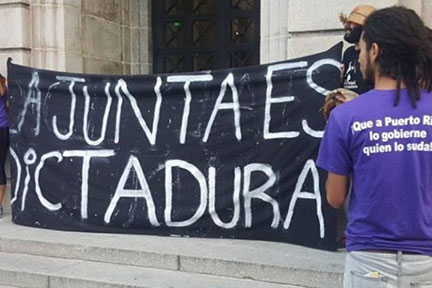 “The Junta Is a
Dictatorship.” Banner in August 30 march against the Financial
Control Board. (Photo:
Metro PR)
“The Junta Is a
Dictatorship.” Banner in August 30 march against the Financial
Control Board. (Photo:
Metro PR)The current crisis, in which Puerto Rico is at the mercy of an unelected Junta de Control Financiero (JCF – in English, Financial Oversight and Management Board), with its recovery from the devastation of hurricanes Irma and María dependent upon FEMA and the U.S. Army Corps of Engineers, is the quintessence of its dependent colonial status. Governor “Ricky” Rosselló and his PNP argue that if Puerto Rico were a state, it would be better able to recover from disasters. You think? Think again. The island might get some more Medicaid dollars, but as for federal aid for relief and rebuilding, all you have to do is look at New Orleans, where the feds’ response to Hurricane Katrina was to drive poor black people out of the city, and Flint, Michigan where FEMA refused to declare the water crisis affecting the largely black city a major disaster.
Various social democrats duck the issue of Puerto Rico’s colonial status while arguing that “Congress can and should provide funds for reconstruction, which also requires the cancellation of Puerto Rico’s public debt,” as two leaders of the Partido del Pueblo Trabajador (PPT, Working People’s Party) wrote in an “Open Letter to the People of the United States” (Counterpunch, 20 October). Likewise, the reformist International Socialist Organization argues that “Puerto Rico’s debt must be forgiven – and the austerity that crippled the island over the past several decades must be reversed” (Socialist Worker, 18 October). This is the same idea put forward by Democratic Party “socialist” Bernie Sanders, although he talks more vaguely of “restructuring” the debt to the vulture capitalists to provide “substantial relief” to Puerto Ricans (El Nuevo Día, 28 November). Since when are Wall Street and the U.S. Congress into “forgiving” the debt and lifting the capitalist austerity that impoverish working people? The only way that will be accomplished is through international socialist revolution.
The Internationalist Group and League for the Fourth International have from the beginning called for the independence of Puerto Rico, and of all colonies. We call for driving out all imperialist troops and bases. In doing so we are upholding the policy of the Third (Communist) International under Lenin and Trotsky, of Trotsky’s Fourth International and of the Spartacist tendency when it was the voice of revolutionary Trotskyism. There can be no just or democratic solution to national and social oppression when an imperialist power rules over a dependent territory, which has been true of Puerto Rico since 1898. It is doubly true today when the Junta appointed by Washington controls the island’s fate despite the charade of local self-government. But even formal independence will not break the stranglehold of imperialism over semi-colonies, which is how the U.S. dominates much of Latin America.
In fact, the deep poverty of the Dominican Republic, Haiti, Jamaica and other Caribbean capitalist countries is one of the main arguments used against Puerto Rican independence. When the Spartacist League and its International Communist League (SL/ICL) announced in 1998 that it no longer advocated independence for the world’s largest remaining colony, the IG denounced this betrayal of communist principle, stressing that the key was Trotsky’s theory and program of permanent revolution, which holds that it is vital “to join together the struggle for emancipation of the subject peoples from imperialism with the fight for proletarian revolution, both in the colony and in the imperialist metropolis” (see “ICL Renounces Fight for Puerto Rican Independence,” The Internationalist No. 6, November-December 1998).
This lesson has been driven home by the aftermath of Hurricanes Irma and María and the criminally negligent “relief” efforts of the capitalist-imperialist rulers that have left millions of Puerto Ricans living in the dark for months. Yet today the ex-Trotskyist SL not only refuses to call unambiguously for Puerto Rican independence, it says it would “support” statehood – that is, annexation by the U.S. which would lead to the destruction of the Puerto Rican nation (see “SL/ICL on Puerto Rico: Annexationist ‘Socialists’”). Meanwhile, it joins the social democrats in calling to “cancel Puerto Rico’s debt” without explaining that this will require overthrowing capitalism, and without presenting a concrete transitional program of revolutionary struggle pointing to that goal.
While Donald Trump pats himself on the back for the responses to the hurricanes in Texas, Florida and Puerto Rico, recovery efforts have been utterly insufficient, as they generally will be under capitalism. Working-class and poor people, who often barely have the means to survive during fair weather, many living in precarious locations, are always far more vulnerable to natural disasters. This is so independent of national borders. In recent months, a September earthquake in Mexico left a death toll of over two hundred people, while an intermittent eruption of Mount Agung in Bali, Indonesia in September and November drove tens of thousands from their homes, recalling the massive earthquake and tsunami of December 2004.2
The bourgeois state is organized to defend the interests of the bourgeoisie, leaving working people on their own in the face of life-threatening crises beyond their control. Under the relative anarchy of capitalist society, individuals fend for themselves trying to escape “natural” disasters, whose causes and consequences are the result of the action and inaction of the ruling classes. In desperately poor Haiti hundreds of thousands died in 2010, and in Puerto Rico likely over a thousand perished due to this year’s hurricanes. It doesn’t have to be like this. Next door in Cuba, in a (bureaucratically deformed) workers state with a planned economy, an elaborate system of collective evacuation and shelter preparations means that the hurricanes that annually tear through the Caribbean cause very few deaths.
As the example of Cuba shows, it is not sufficient to demand national independence under the Puerto Rican bourgeoisie. To carry out the program of permanent revolution, it is necessary to build a genuinely Trotskyist, revolutionary internationalist workers party in Puerto Rico, part of a reforged Fourth International that can lead the fight for socialist revolution the world over. ■
- 1. CPRS, Estimates of Post-Hurricane Maria Exodus from Puerto Rico (October 2017)
- 2. See “Capitalist Tidal Wave of Death” and other articles in the special issue on the “Asian Tsunami Disaster,” The Internationalist No. 20, January-February 2005. See also “Haiti Earthquake: Capitalism, Occupation and Revolution” and related articles in The Internationalist No. 31, Summer 2010.
